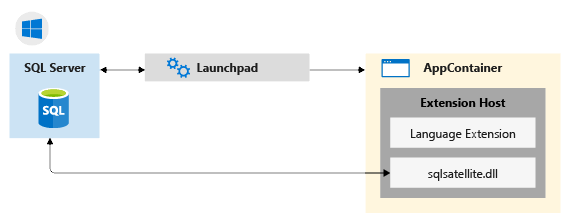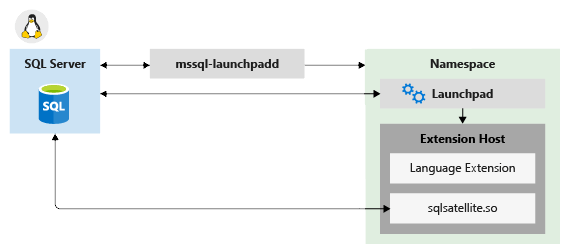Extensibility architecture in SQL Server Language Extensions
Applies to:
SQL Server 2019 (15.x) and later versions
Learn about the extensibility architecture used for SQL Server Language Extensions, which allows you to run external code in SQL Server. Java, Python, and R are supported in SQL Server 2019 (15.x) and later versions. The code executes in a language runtime environment as an extension to the core database engine.
Background
The purpose of the extensibility framework is to provide an interface between SQL Server and external languages. Database administrators can maintain security by executing a trusted language within a secure framework managed by SQL Server, while allowing data scientists access to enterprise data.
Any supported external language can be run by calling a stored procedure and the results are returned as tabular results directly to SQL Server. This makes it easy to use the external language from any application that can send a SQL query and handle the results.
Architecture diagrams
The architecture is designed such that external code run in a separate process from SQL Server, but with components that internally manage the chain of requests for data and operations on SQL Server.
Component architecture in Windows:

Component architecture in Linux:

Components include a Launchpad service used to invoke external runtimes (for example, Java) and library-specific logic for loading interpreters and libraries.
Launchpad
The SQL Server Launchpad is a service that manages the life-time, resources, and security boundaries of the external process that's responsible for script execution. This is similar to the way that the full-text indexing and query service launches a separate host for processing full-text queries. The Launchpad service can start only trusted launchers published by Microsoft, or certified by Microsoft as meeting requirements for performance and resource management.
The SQL Server Launchpad service runs under SQLRUserGroup which uses AppContainers for execution isolation.
A separate SQL Server Launchpad service is created for each database engine instance to which you add SQL Server Machine Language Extensions. There's one Launchpad service for each database engine instance, so if you have multiple instances with external script support, you have a Launchpad service for each one. A database engine instance is bound to the Launchpad service created for it. All invocations of an external script in a stored procedure or T-SQL, result in the SQL Server service calling the Launchpad service created for the same instance.
To execute tasks in a specific supported language, the Launchpad gets a secured worker account from the pool, and starts a satellite process to manage the external runtime. Each satellite process inherits the user account of the Launchpad and uses that worker account during script execution. If script uses parallel processes, they're created under the same, single worker account.
Communication channels between components
Communication protocols among components and data platforms are described in this section.
TCP/IP
By default, internal communications between SQL Server and the SQL satellite use TCP/IP.
ODBC
Communication between external data science clients and a remote SQL Server instance uses ODBC. The account that sends the script jobs to SQL Server must have both permissions to connect to the instance and to run external scripts.
Additionally, depending on the task, the account might need these permissions:
- Read data used by the job
- Write data to tables: for example, when saving results to a table
- Create database objects: for example, if saving external script as part of a new stored procedure
When SQL Server is used as the compute context for script executed from a remote client, and the executable must retrieve data from an external source, ODBC is used for writeback. SQL Server maps the identity of the user issuing the remote command to the identity of the user on the current instance, and runs the ODBC command using that user's credentials. The connection string needed to perform this ODBC call is obtained from the client code.
Other protocols
Processes that might need to work in "chunks" or transfer data back to a remote client can also use the XDF file format. Actual data transfer is via encoded blobs.